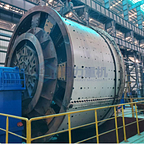The Revolution of Vertical Roller Mills in the Industry: Transforming the Grinding Landscape
Cement Grinding Plant’s Unique Challenges
Cement is a high-energy-consuming industry that requires a significant amount of energy during its production process. Electrical consumption in the cement grinding stage accounts for approximately one-third of the total electricity consumption in cement production. Therefore, reducing the electrical consumption in the cement grinding section can effectively promote the sustainable development of the cement industry. Currently, the most widely used cement grinding systems are the combined grinding system consisting of roller press and ball mill and the finish grinding system using vertical mills. Due to the advantages of energy efficiency and space savings, vertical mills have gradually gained attention. According to statistics, over 70% of newly built cement production lines worldwide adopt vertical mill grinding systems. However, domestic cement companies have doubts about whether vertical mill grinding can truly save energy and whether the performance of cement after grinding meets the requirements. These doubts have hindered the development of vertical mill grinding systems in China.”
Optimizing Energy Efficiency in Cement Grinding: The Impact of Innovative Grinding Methods
The key factors influencing energy consumption in the cement grinding section are the grinding methods of the main equipment. The grinding process in a ball mill relies on the impact and friction of grinding media, resulting in significant energy losses and low efficiency. In contrast, the combined grinding system of roller press and ball mill utilizes the roller press to crush the material cake, achieving a certain fineness through multiple grinding cycles before further refinement with a ball mill, thus enhancing particle roundness. Vertical roller mills (VRMs) use grinding rollers and discs to compress and grind, resulting in higher cement particle roundness and lower water demand for standard consistency. Moreover, VRMs come with highly efficient separator units, enabling ‘grind-and-select’ capability, preventing over-grinding, and saving energy.
Elevating Grinding Excellence: Why Vertical Roller Mills Outshine HPGR
The vertical roller mill grinding system offers a cost-effective solution with its open-air layout. It occupies approximately 77.4% less ground area compared to the combined roller press and ball mill grinding system, and requires only 64.3% of the building area. Additionally, the equipment investment is significantly lower, at approximately 95.9% less than the roller press and ball mill combined grinding system. In terms of installation and construction investments, the vertical roller mill system outperforms the combined system.
Furthermore, the construction period for the vertical roller mill grinding system is notably shorter. Typically, it takes only 6 to 7 months from civil engineering work to installation, reducing the timeline by around 1 month compared to the combined grinding system.”
Revolutionizing Cement Grinding: The Advantages of Vertical Roller Mill Systems
The vertical roller mill powder grinding system features a simple process flow with minimal equipment, including only the cement vertical roller mill, primary bag dust collector, and main exhaust fan. It significantly enhances reliability and automation, resulting in lower failure rates. In contrast, the roller press + ball mill combined grinding system comprises multiple components such as the V-type separator, roller press, high-efficiency separator, circulating fan, ball mill, O-Sepa separator, primary bag filter, main exhaust fan, mill tail dust collector, and mill tail exhaust fan, leading to a more complex process and higher maintenance requirements.
The vertical mill final grinding system operates without the metal impact sounds of steel balls colliding with liners, reducing noise levels by 20~25dB compared to ball mill grinding systems, greatly improving worker comfort. Additionally, the vertical mill final grinding system operates under negative pressure and is equipped with efficient bag filters, resulting in minimal on-site dust emissions, with dust emission levels surpassing those of the combined grinding system.
Moreover, adjusting the grinding pressure and separator speed in the central control room allows for easy adaptation to various cement types and mixtures, whereas the combined grinding system requires regrinding. Furthermore, the vertical roller mill demonstrates greater adaptability to materials, especially for challenging materials with high moisture content and poor grindability, such as slag, steel slag, and furnace bottom slag commonly found in cement raw materials.
Zhejiang Tongli Heavy Machinery Youtube Channel:
Reference:
Date: 2023–10–7
Author: Richard.Z
